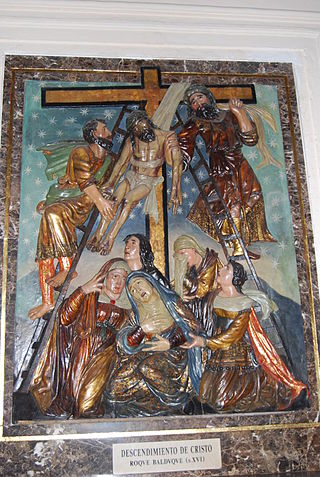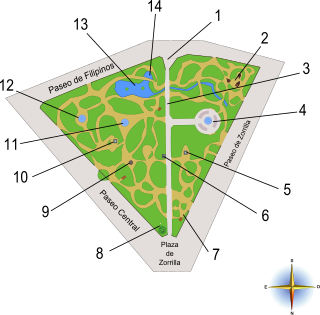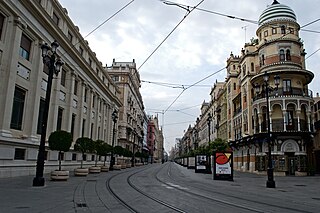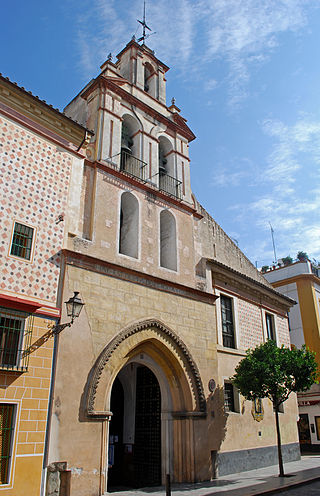
Seville is the capital and largest city of the Spanish autonomous community of Andalusia and the province of Seville. It is situated on the lower reaches of the River Guadalquivir, in the southwest of the Iberian Peninsula.

The Seville Metro is an 18-kilometre (11 mi) light metro network serving the city of Seville, Spain and its metropolitan area. The system is totally independent of any other rail or street traffic. All stations are provided with platform screen doors.

Carmona is a town of southwestern Spain, in the province of Seville; it lies 33 km north-east of Seville.

Écija is a city and municipality of Spain belonging to the province of Seville, in the autonomous community of Andalusia. It is in the countryside, 85 km east of the city of Seville. According to the 2008 census, Écija had a total population of 40,100 inhabitants, ranking as the fifth most populous municipality in the province. The river Genil, the main tributary of the river Guadalquivir, runs through the city.

Rímac, known until the 19th century as the neighbourhood of San Lázaro, is a district in the Lima Province, Peru. It lies directly to the north of downtown Lima, to which it is connected by six bridges over the Rímac River. The district also borders the Independencia, San Martín de Porres, and San Juan de Lurigancho districts. Vestiges of Lima's colonial heyday remain today in an area of the Rímac district known as the Historic centre of Lima, which was declared a UNESCO World Heritage Site in 1988. Downtown Rímac District has, like its southern counterpart, its eastern and western sides divided by Jirón Trujillo, which connects to Lima District's Jirón de la Unión through the Puente de Piedra, the oldest bridge in the whole city. Rímac's East side features the Plaza de Acho, the most famous bullfighting arena in South America and one of the most well known in the world.
Antonio Cruz García, known as Antonio Mairena (1909–1983), was a Spanish musician, who tried to rescue a type of flamenco, which he considered to be pure or authentic. He rescued or recreated a high number of songs that had been almost lost, and also published several books and articles to divulge his views on flamenco and flamenco history. He considered himself as heir to the art of Manuel Torre, the most classic flamenco singer from Jerez, and also acknowledged the influence of other masters like Tomás Pavón or Joaquín el de la Paula.

Holy Week in Seville is one of two biggest annual festivals in Sevilla, Andalucía, Spain, the other being the Feria de Abril, which follows two weeks later. It is celebrated in the week leading up to Easter, and features the procession of pasos, floats of lifelike wooden sculptures of individual scenes of sorrowful Mysteries of the Rosary, or images of the grieving Virgin Mary.

The Alameda de Hércules , or simply La Alameda, is a garden square or mall in Seville, southern Spain. Built in 1574, it was originally a promenaded public garden, named after the eight rows of white poplar trees that fill its central part. Located in the northern half of the city's casco antiguo, between the Guadalquivir River and the Macarena neighbourhood, it was the oldest public garden in Spain and Europe.

Gines is a municipality in the south-west Spain, in the province of Seville, Andalusia. It is part of the metropolitan area of Seville. Gines has a population of 13,529 inhabitants as of 2021 and an area of 2.9 km2 (1.1 sq mi).

The Via Crucis to the Cruz del Campo in Seville, Andalusia, Spain is believed to be Spain's only Via Crucis that runs through the streets of a city. It is the basis of the famous traditions of Holy Week in Seville. Since the Via Crucis was first laid out in 1521, both the starting and ending points have changed, as has the number of stations.

Roque Balduque was a sculptor and maker of altarpieces. Born at an unknown date in Bois-le-Duc, he is known for his work in Spain in the last years of his life.

The Campo Grande is a large public park located in the heart of the city of Valladolid, Spain. It is triangular, has a 115,000 m² surface and is bordered by the streets Acera de Recoletos, Paseo de los Filipinos and Paseo de Zorrilla. Its main entrance is at Plaza de Zorrilla, where together with a modern bill gate lies a floral shield of the city. The park is enclosed around its perimeter by a simple fence that runs between pillars, with entrances on all sides.

The 2023 Seville City Council election, also the 2023 Seville municipal election, was held on Sunday, 28 May 2023, to elect the 12th City Council of the municipality of Seville. All 31 seats in the City Council were up for election. The election was held simultaneously with regional elections in twelve autonomous communities and local elections all throughout Spain.

Avenida de la Constitución is an important avenue in the Casco Antiguo district of Seville, Andalusia, Spain. It starts from the square known as Puerta de Jerez and reaches the Plaza Nueva, considered the center of the city and where the historic building of the Seville City Council is located. It has a length of 600 m (0.37 mi).

The Paseo de Aguas is a promenade located in Jirón Madera of Rímac District, Lima, Peru. It was built between 1770 and 1776 by Viceroy Manuel de Amat y Juniet. Located nearby are the Alameda de los Descalzos and the Acho bullring. It has the colonial part of the main arch and remains of the side wall dating from the 18th century, as well as gardens, fountains, games and waterfalls. It was remodeled in 2014.

The Church of Santa María la Blanca is located in the San Bartolomé neighborhood of the district of Casco Antiguo in Seville. It was built in the 17th century. It is the headquarters of the Brotherhood of the Rosary of Our Lady of the Snows.

The Alameda de los Descalzos is an alameda located in Rímac District, Lima, Peru. One of the best-known places in the district, around it stand—among other buildings—the churches of Santa Liberata, El Patrocinio and Nuestra Señora de los Ángeles. Nearby is also the place where Micaela Villegas's Mill House was located. It measures about 450 m.

The Trinitarian Church of Lima is a Catholic church and monastery in the colonial area of the neighbourhood of Barrios Altos in Lima, Peru. Located in the corner of Áncash and Paruro streets, it was built in a baroque and neoclassical style in 1722.

The Church and Convent of the Good Death, also known as the Church of Saint Camillus, after the order's founder, is a Catholic church and convent in the colonial area of the neighbourhood of Barrios Altos in Lima, Peru. The current temple was built at the end of the 19th century and is dedicated to Our Lady of the Good Death. It is located at the crossroads of the Áncash and Paruro streets, and is diagonal to the Trinitarian Church of Lima.

The Church of the Sanctuary is a Catholic church in Lima, Peru. It is located on the second block of the Jirón Carabaya, between the Archbishop's Palace and the Cathedral, and facing the main square of the city. The building houses the baptism, marriage and death certificates of a number of important figures in the history of the city.



















